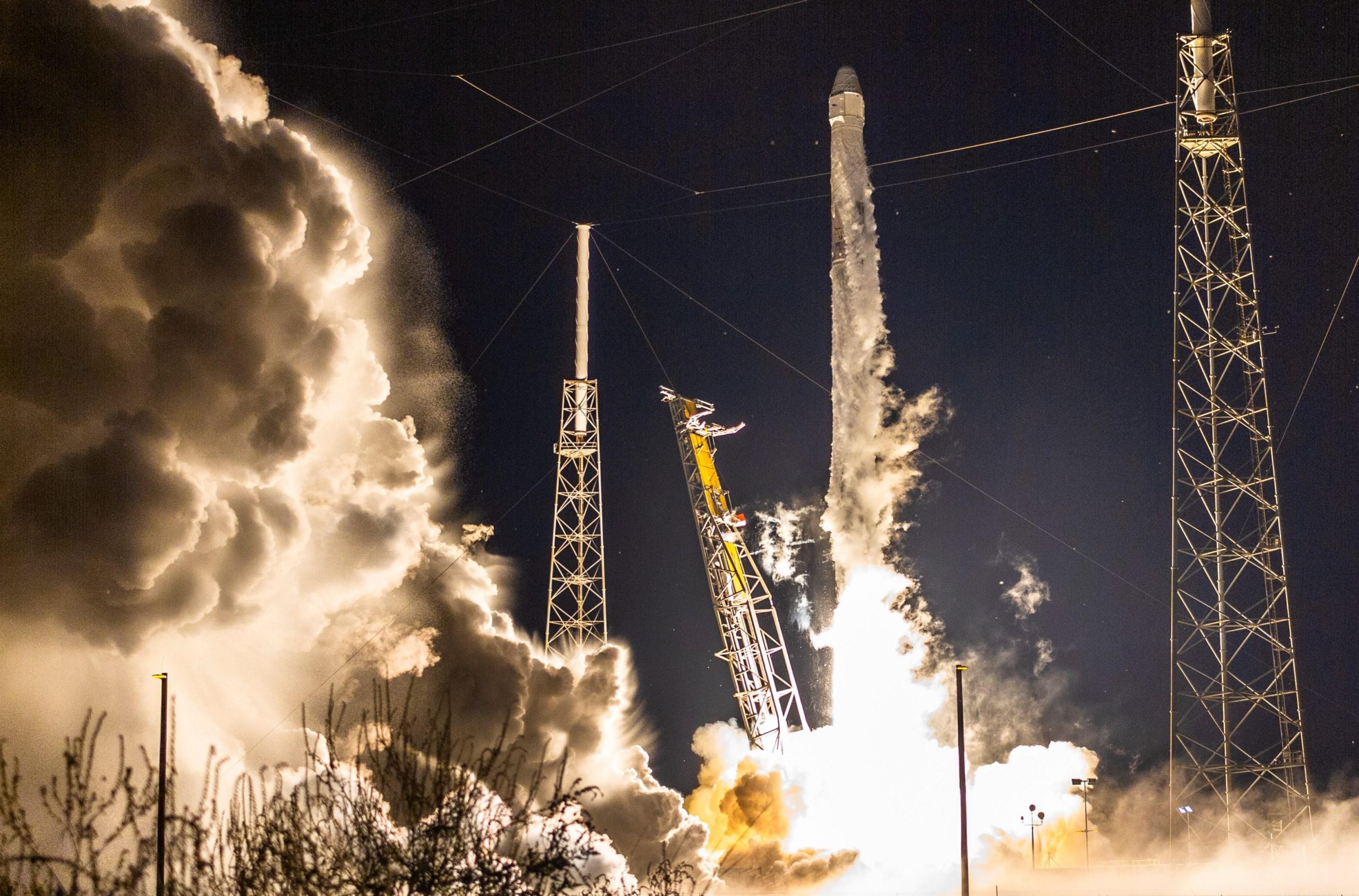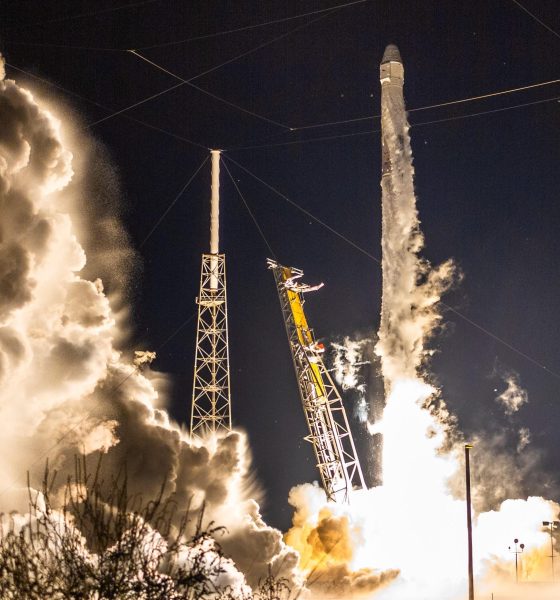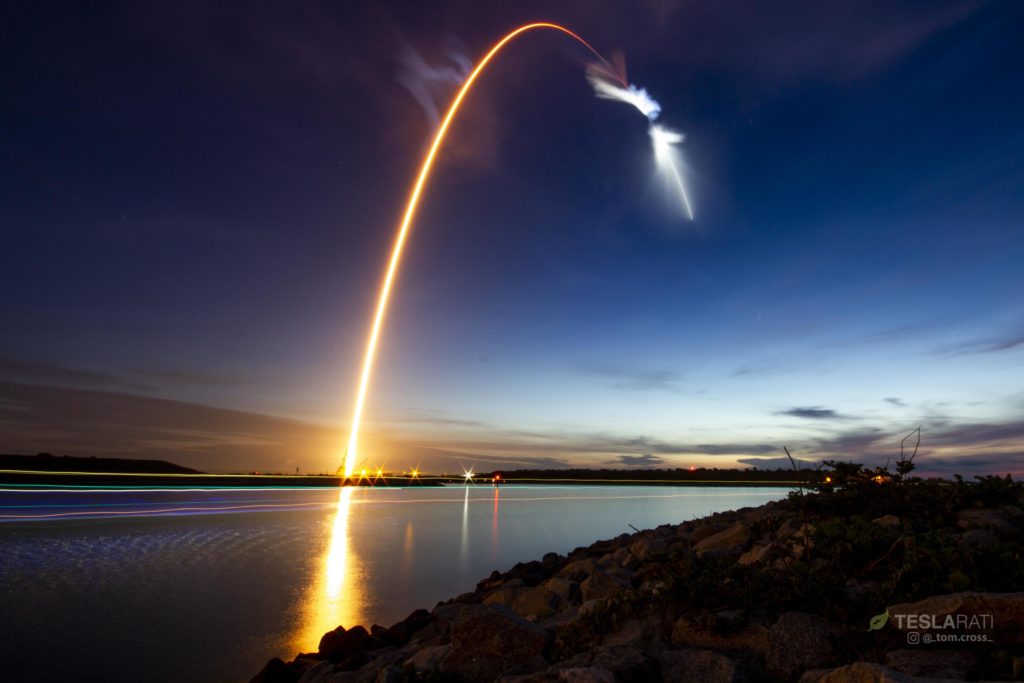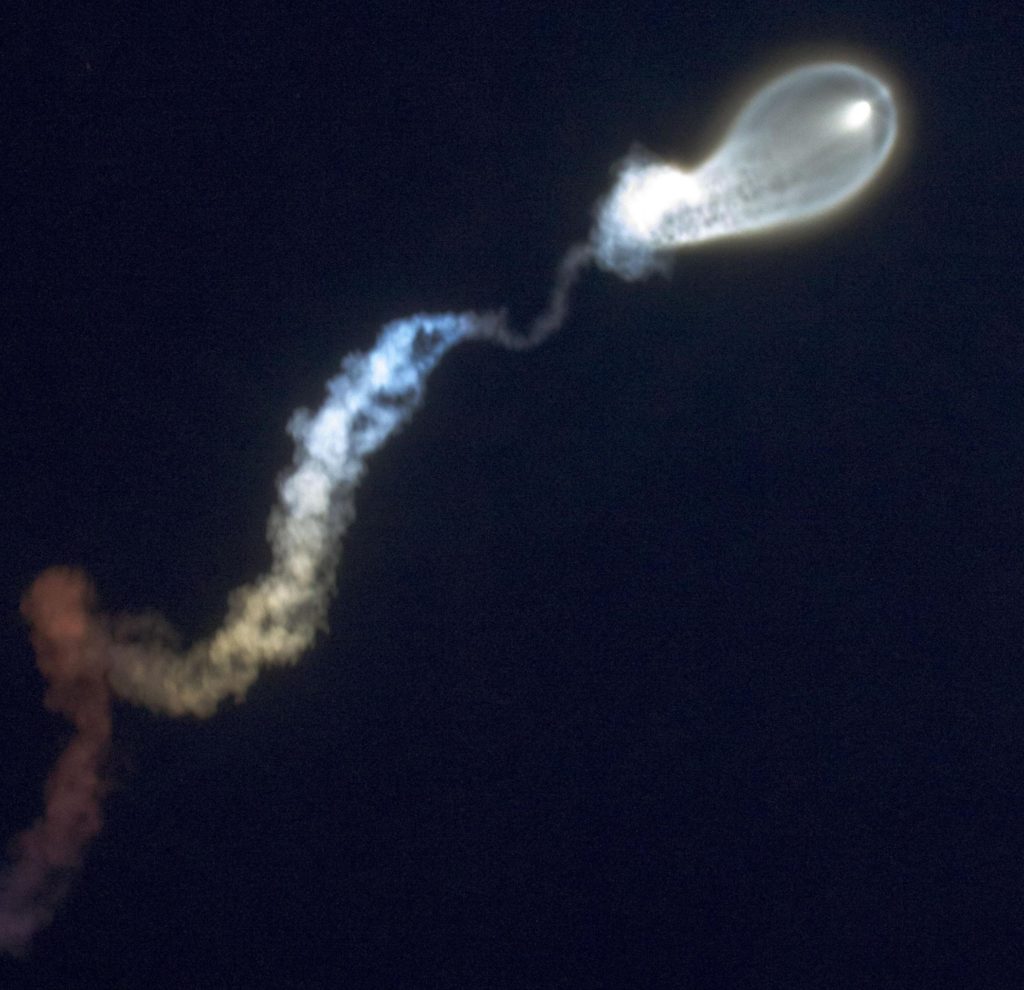

News
SpaceX bids goodbye to older Falcon 9s with Florida ‘jellyfish’ launch spectacle
SpaceX’s final Block 4 Falcon 9 has completed its second and last orbital mission with a spectacular sendoff visible for hundreds of miles along the East Coast, harkening back to “alien invasion” comparisons that followed an equally stunning SpaceX launch from California last December.
Although the Falcon 9 booster was expended in the Atlantic Ocean minutes after launch, its upper stage remains in orbit in an experimental test of its lifespan, while the mission’s flight-proven Cargo Dragon spacecraft separated from the rocket and headed to the International Space Station with a promise of a possible third orbital reuse in 2019. This mission’s Dragon capsule flew for the first time in late 2016 for the CRS-9 mission and spent the two years since then having its heat shield and other major components refurbished or replaced, likely at a cost to SpaceX less than half that of constructing a brand-new Dragon spacecraft.

Falcon 9 B1045 lounges in the Florida summer humidity, hours before its second and final launch. (Tom Cross)
According to Jessica Jensen, SpaceX’s Director of Dragon Mission Management, SpaceX’s Dragon refurbishment team has also gotten considerably more efficient over several years of experience reusing the orbital spacecraft, now up to three reflights of three separate capsules. She noted in the postlaunch conference that – if all major components are healthy upon CRS-15’s early-August return to Earth – this capsule could be refurbished for its third mission in as few as months, which would make it one of the last Dragon 1 launches before the upgraded Dragon 2 begins crewed flights and takes over all cargo missions. After CRS-15, five more of those Cargo Dragon flights remain until CRS-2’s 2020 takeover, all of which will utilize flight-proven capsules.
- CRS-15’s dramatic pre-dawn launch. (Tom Cross)
- The extraordinary plume was lit up by the sun before it had risen above the Eastern horizon. (Tom Cross)
Falcon 9, on the other hand, reached a truly historic milestone today for SpaceX – B1045’s second and final flight marks the last rocket SpaceX will fly that does not feature a number of upgrades designed to dramatically improve booster reusability. Known as Falcon 9 Block 5, all future SpaceX missions (at least until BFR’s debut sometime in the early 2020s) will be launched aboard the upgraded rocket. If it works as intended, Block 5 should theoretically enable a rapid and affordable level of reusability never before achieved by Falcon 9 or any other rocket, for that matter.
https://twitter.com/_TomCross_/status/1012694524987092992
While still more than a little disheartening to see a Falcon 9 booster intentionally expended after launch, the spectacle created by B1045’s final flight was fitting, to say the least. Thankfully, the Block 5 takeover of all future SpaceX Falcon 9 and Falcon Heavy launches is likely to also result in a dramatic reduction in SpaceX’s willingness to expend flight-proven rockets after launch. Whereas Block 3 and 4 Falcon 9s were never designed to affordably and safely fly more than two or three times total, minimizing any opportunity cost from expending twice-flown rockets after launch, Block 5 has been purpose-built to allow individual boosters to fly a bare minimum of 10 times with minimal refurbishment and as many as 100 times with regular maintenance. Unless Block 5’s design fails to achieve that level of reusability, SpaceX is extremely unlikely to expend Block 5 boosters unless they have flown a number of times to extract as much value as possible from them.
Up next on SpaceX’s manifest are two back-to-back Falcon 9 Block 5 launches, Iridium-7 from California on July 20 and Telstar 19V from Florida less than 18 hours later. Both Block 5 boosters will be recovered aboard SpaceX’s fleet of drone ships, Just Read The Instructions (JRTI) to the West and Of Course I Still Love You (OCISLY) to the East.
Follow us for live updates, peeks behind the scenes, and photos from Teslarati’s East and West Coast photographers.
Teslarati – Instagram – Twitter
Tom Cross – Twitter
Pauline Acalin – Twitter
Eric Ralph – Twitter

News
Man credits Grok AI with saving his life after ER missed near-ruptured appendix
The AI flagged some of the man’s symptoms and urged him to return to the ER immediately and demand a CT scan.

A 49-year-old man has stated that xAI’s Grok ended up saving his life when the large language model identified a near-ruptured appendix that his first ER visit dismissed as acid reflux.
After being sent home from the ER, the man asked Grok to analyze his symptoms. The AI flagged some of the man’s symptoms and urged him to return immediately and demand a CT scan. The scan confirmed that something far worse than acid reflux was indeed going on.
Grok spotted what a doctor missed
In a post on Reddit, u/Tykjen noted that for 24 hours straight, he had a constant “razor-blade-level” abdominal pain that forced him into a fetal position. He had no fever or visible signs. He went to the ER, where a doctor pressed his soft belly, prescribed acid blockers, and sent him home.
The acid blockers didn’t work, and the man’s pain remained intense. He then decided to open a year-long chat he had with Grok and listed every detail that he was experiencing. The AI responded quickly. “Grok immediately flagged perforated ulcer or atypical appendicitis, told me the exact red-flag pattern I was describing, and basically said “go back right now and ask for a CT,” the man wrote in his post.
He copied Grok’s reasoning, returned to the ER, and insisted on the scan. The CT scan ultimately showed an inflamed appendix on the verge of rupture. Six hours later, the appendix was out. The man said the pain has completely vanished, and he woke up laughing under anesthesia. He was discharged the next day.
How a late-night conversation with Grok got me to demand the CT scan that saved my life from a ruptured appendix (December 2025)
byu/Tykjen ingrok
AI doctors could very well be welcomed
In the replies to his Reddit post, u/Tykjen further explained that he specifically avoided telling doctors that Grok, an AI, suggested he get a CT scan. “I did not tell them on the second visit that Grok recommended the CT scan. I had to lie. I told them my sister who’s a nurse told me to ask for the scan,” the man wrote.
One commenter noted that the use of AI in medicine will likely be welcomed, stating that “If AI could take doctors’ jobs one day, I will be happy. Doctors just don’t care anymore. It’s all a paycheck.” The Redditor replied with, “Sadly yes. That is what it felt like after the first visit. And the following night could have been my last.”
Elon Musk has been very optimistic about the potential of robots like Tesla Optimus in the medical field. Provided that they are able to achieve human-level articulation in their hands, and Tesla is able to bring down their cost through mass manufacturing, the era of AI-powered medical care could very well be closer than expected.
News
Tesla expands Model 3 lineup in Europe with most affordable variant yet
The Model 3 Standard still delivers more than 300 miles of range, potentially making it an attractive option for budget-conscious buyers.

Tesla has introduced a lower-priced Model 3 variant in Europe, expanding the lineup just two months after the vehicle’s U.S. debut. The Model 3 Standard still delivers more than 300 miles (480 km) of range, potentially making it an attractive option for budget-conscious buyers.
Tesla’s pricing strategy
The Model 3 Standard arrives as Tesla contends with declining registrations in several countries across Europe, where sales have not fully offset shifting consumer preferences. Many buyers have turned to options such as Volkswagen’s ID.3 and BYD’s Atto 3, both of which have benefited from aggressive pricing.
By removing select premium finishes and features, Tesla positioned the new Model 3 Standard as an “ultra-low cost of ownership” option of its all-electric sedan. Pricing comes in at €37,970 in Germany, NOK 330,056 in Norway, and SEK 449,990 in Sweden, depending on market. This places the Model 3 Standard well below the “premium” Model 3 trim, which starts at €45,970 in Germany.
Deliveries for the Standard model are expected to begin in the first quarter of 2026, giving Tesla an entry-level foothold in a segment that’s increasingly defined by sub-€40,000 offerings.
Tesla’s affordable vehicle push
The low-cost Model 3 follows October’s launch of a similarly positioned Model Y variant, signaling a broader shift in Tesla’s product strategy. While CEO Elon Musk has moved the company toward AI-driven initiatives such as robotaxis and humanoid robots, lower-priced vehicles remain necessary to support the company’s revenue in the near term.
Reports have indicated that Tesla previously abandoned plans for an all-new $25,000 EV, with the company opting to create cheaper versions of existing platforms instead. Analysts have flagged possible cannibalization of higher-margin models, but the move aims to counter an influx of aggressively priced entrants from China and Europe, many of which sell below $30,000. With the new Model 3 Standard, Tesla is reinforcing its volume strategy in Europe’s increasingly competitive EV landscape.
News
Tesla FSD (Supervised) stuns Germany’s biggest car magazine
FSD Supervised recognized construction zones, braked early for pedestrians, and yielded politely on narrow streets.

Tesla’s upcoming FSD Supervised system, set for a European debut pending regulatory approval, is showing notably refined behavior in real-world testing, including construction zones, pedestrian detection, and lane changes, as per a recent demonstration ride in Berlin.
While the system still required driver oversight, its smooth braking, steering, and decision-making illustrated how far Tesla’s driver-assistance technology has advanced ahead of a potential 2026 rollout.
FSD’s maturity in dense city driving
During the Berlin test ride with Auto Bild, Germany’s largest automotive publication, a Tesla Model 3 running FSD handled complex traffic with minimal intervention, autonomously managing braking, acceleration, steering, and overtaking up to 140 km/h. It recognized construction zones, braked early for pedestrians, and yielded politely on narrow streets.
Only one manual override was required when the system misread a converted one-way route, an example, Tesla stated, of the continuous learning baked into its vision-based architecture.
Robin Hornig of Auto Bild summed up his experience with FSD Supervised with a glowing review of the system. As per the reporter, FSD Supervised already exceeds humans with its all-around vision. “Tesla FSD Supervised sees more than I do. It doesn’t get distracted and never gets tired. I like to think I’m a good driver, but I can’t match this system’s all-around vision. It’s at its best when both work together: my experience and the Tesla’s constant attention,” the journalist wrote.
Tesla FSD in Europe
FSD Supervised is still a driver-assistance system rather than autonomous driving. Still, Auto Bild noted that Tesla’s 360-degree camera suite, constant monitoring, and high computing power mark a sizable leap from earlier iterations. Already active in the U.S., China, and several other regions, the system is currently navigating Europe’s approval pipeline. Tesla has applied for an exemption in the Netherlands, aiming to launch the feature through a free software update as early as February 2026.
What Tesla demonstrated in Berlin mirrors capabilities already common in China and the U.S., where rival automakers have rolled out hands-free or city-navigation systems. Europe, however, remains behind due to a stricter certification environment, though Tesla is currently hard at work pushing for FSD Supervised’s approval in several countries in the region.










